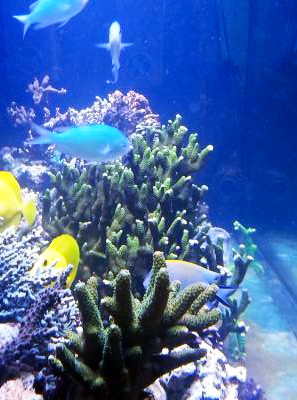In the first installment of this series, we examined the confirmable uses of ozone gas in the home aquarium. We saw ozone having a positive effect on the nitrogen cycle and doing a great job creating ultra-clear water conditions by breaking up suspended particles. We also examined the biggest myth of using ozone—that it will sterilize your water. It is true that ozone will kill bacteria, but we use ozone at a level far below what is required to kill the majority of bacteria.
Today we will look at the most common means of using ozone in the home aquarium and how to select the right system for creating and applying ozone.
Ozone is created by intense electrical discharges. In nature, that means lightning bolts. At home, we can also create ozone by using an electrical discharge device (imagine a spark plug and a current jumping the gap as air passes over it).
Skimmer injection
Ozone is a gas at room temperature, which makes injecting it into your skimmer an ideal application method. A skimmer draws air into its chamber at such an angle as to maximize contact time with the water. This means that ozone will also have the maximum contact with the water.
Injection is accomplished by feeding the output gas line from the ozone generator into the air intake line of the skimmer. As a result, the skimmer is forced to pull its air from the generator. Note that some skimmers induce enough gas flow to eliminate the need for an external additional air pump to force all the ozone into the chamber, while smaller and lower-efficiency skimmers will require an air pump to ensure all the ozone is pushed into the skimmer.
Dedicated reactor
An alternative method of dosing your aquarium with ozone is to use a dedicated reactor. A quick internet search will yield numerous versions of DIY reactors for those who are handy. Also, a few companies offer professionally built models for those of us who are all thumbs. The reactors do take up extra space and require the extra air pump. For those with the space, the reactor is purported to be more effective than skimmer injection. However, it is unclear whether the gains in efficiency justify the additional space and costs.
Choosing an ozone reactor
Selecting the proper ozone reactor is a fairly simple process. Look for a model that features a replaceable corona discharge unit (its spark plug) and is otherwise maintenance-free. Most popular units produce 200 mg/hr of ozone gas, which will allow the user to upgrade to a larger tank without having to replace the unit. 200 mg/hr is far higher than most aquariums can handle, so it is important to look for a unit that features output level regulating controls. This gives the user more flexibility than any external controller alone will provide.
Other parts of the system

Moisture in the air reduces ozone production, so an air dryer unit should be used on the intake side of the generator. It is recommended to own two such units, allowing you to avoid having the generator running without the dryer while you are recycling the beads of the unit that has become saturated. The bigger the dryer unit, the longer it takes to become saturated. Ozone degrades normal air tubing, so all lines that come in contact with the ozone should be silicone-based tubes.
The most important part of any good system is a well-made controller. This can be as simple as a stand-alone unit or part of an overall aquarium-management system. The controller needs to monitor the Oxidation/Reduction Potential, or ORP, to ensure that there is an upper limit to how much ozone enters the aquarium. Controllers are highly recommended for all sizes of aquaria but considered an absolute must for small systems (under 150 gallons). The probe needs to be placed in the sump where it will be exposed to constant flow of water from the display tank.
Many aquarium supply companies offer some sort of package deal that includes a generator, monitor, probe, and dryer unit. However, not all bundle deals are the best deals. Read reviews of each piece in the kit to ensure that you’re getting the right fit for your system and budget.
Don’t miss Part 3!
Be sure to look for Part 3, in which we’ll examine how to keep yourself and your aquarium safe while using ozone. The first installment can be found here – Clearing the Air on Ozone: Part 1



